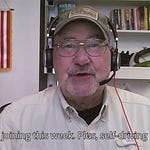An under-strength force of 358 soldiers of the 20th Maine Regiment, a third of whom were mutineers intending desertion, suddenly found itself standing alone against Confederate troops ready to brush them aside and roll up the entire Union line.
Already having withstood several uphill infantry charges from Alabama veterans in the waning afternoon, the northerners’ ammunition was virtually exhausted. They would not be able to withstand another assault.
Through the gathering dusk in the forested slopes below the Yankees, Rebel troops could be seen gathering for one more final, decisive attack.
Union Colonel Lawrence Joshua Chamberlain, a mild-mannered 34-year-old professor of modern languages from Bowdoin College, realized it was a now-or-never moment. Drawing his sword, he screamed, “Bayonets!” and led his men forward, downhill, into Southern muskets only 30 yards distant. His regiment, spurred by junior officers and sergeants, followed with a ferocity borne of terror and adrenaline.
The Killer Angels
The first time I became aware of Joshua Chamberlain was in a free audiobook I received from Audible dot com for some customer-appreciation event. Michael Sharra’s brilliant The Killer Angels is the second of a three-part series starting with Gods and Generals and ending with The Last Full Measure.
The Killer Angels, like its companion works, is an historical novel. It was adapted for film in Gettysburg, 1993. Later, the 3.5-hour movie version of the prequel Gods and Generals put me to sleep. I was apparently not alone; unfortunately, Gods and Generals was a box office failure and thus doomed the prospects for a third movie to complete the set.
The threat
By 1863, the American Civil War had dragged on for two astonishing, bloody years. The states of the North, vastly superior to those of the South in terms of population, wealth and manufacturing capacity, fielded huge armies. Inept leadership brought home defeat after defeat. Low morale swept the Northern (Union) ranks.
Seeking a final death-blow, Southern (Confederate) General Robert E. Lee led his army north. His plan was to drive his forces between the capitol city of Washington, D.C., and the Union’s Army of the Potomac, which was then in the field, a hundred miles northwest of the capital.
Separating the North’s government from their army would allow Lee’s forces to occupy the capital and cut the head off the Union. The place Lee chose for this decisive battle was a small town in southern Pennsylvania.
Without the quick thinking and sudden, violent response of the 20th Maine, it would have succeeded.
A theatre of battle
On a hot July day in 1863 south of Gettysburg, Pennsylvania, Union General George Gordon Meade had deployed his Army of the Potomac in a north-to-south line along the heights of Cemetery Ridge. The southern tip of his line — his left flank — was anchored on Little Round Top, an unremarkable, bald, rocky hill.
The 20th Maine, under command of Colonel Lawrence Joshua Chamberlain, was at the very tip of the left end of the Union line. As such, it was deployed around the perimeter of Little Round Top in a shape more resembling a fish hook than a line.
Confederate General James Longstreet, despite the grievous personal tragedy of losing all three of his youngest children to scarlet fever a few months earlier, deployed his troops, under Lee’s orders, at the southern end of the Union line. On the afternoon of July 2, 1863 — the second day of the three-day Battle of Gettysburg — Longstreet ordered the 15th Alabama Infantry Regiment to attack and occupy Little Round Top.
If Longstreet’s flanking maneuver succeeded, it would open a door for his entire corps to roll through the Union forces south-to-north, attacking each Union position piecemeal. It would force Union troops to suddenly reorient themselves to defend against an attack from their left side, rather than from their front. Given their entrenched positions, the North would not be able to respond to the rapidly changing battle.
If the 15th Alabama could succeed, Gettysburg could become yet another glorious Southern victory. The permanent fracture of the United States would be within reach.
Enter Joshua Chamberlain.
Genius meets urgency
Robert E. Lee was a tactical battlefield genius with an uncanny ability to read the land and exploit with boldness the weak points of his foe’s disposition. By contrast, Joshua Chamberlain, although descended from an unbroken line of American military officers dating back to the French & Indian War, was a student of languages, unaccustomed to the study of military tactics.
However, Chamberlain was intelligent in his assessments and quick in his actions. Through the previous defenses against the Alabama attacks that afternoon, he saw his line doubled back on itself. His regiment, ostensibly facing west toward the enemy, was now actually facing southeast as it was encircled from the base of the hill.
Michael Sharra in The Killer Angels portrays the scene as fiction, but the action is likely an approximation of the truth. In his telling, Sharra’s Chamberlain asks the Irish Sergeant how much ammunition the men have remaining.
I no longer have my copy of The Killer Angels paperback (probably having loaned it to one of you reading this) but as I recall, the sergeant’s answer was two or three rounds per man. Repelling each previous assault had required at least six rounds each from their muzzle-loaders.
It did not take a trained tactician to understand the 20th Maine would be overwhelmed in the next few minutes.
“Fix bayonets!”
In the dimness of 160 years of history, it is impossible now to determine exactly what order Chamberlain gave. It seems clear that he ordered a “right-wheel,” meaning that the regiment would lead from the left-most units and swing to their right as they moved against the enemy. They would act like a door, hinged at their right, as they moved against the Rebels.
The single word “Bayonets!” may have been the beginning of the shouted command, but if other words followed, they were lost in the scrape of blades being fixed, officers screaming orders, and the rattle of muskets.
A frenzied, terrifying downhill assault of naked blades, lunging across bare ground and into the forest beyond, shocked the Southern would-be attackers. Still, they would likely have held their ground were it not for the unplanned, last-second action of other Union troops suddenly firing into the Confederates from the rear.
It was the last effort of James Longstreet’s attempts to flank and turn the Union line. Both sides retired for the night.
Down and out
For Confederate General Robert E. Lee, it left him few options other than the disastrous, ill-fated charge the following day. What has become known as “Pickett’s Charge” saw over 12,000 Confederate troops march across a mile of open terrain into murderous cannon fire in a failed frontal assault on the Union center at Cemetery Ridge.
Half the Rebels were left dead or wounded under the sweltering Pennsylvania sun. The other half dragged themselves back to their lines, bloodied and dispirited.
While the War of the Rebellion continued two more years, Gettysburg was the turning point.
Joshua Chamberlain, wounded 6 times in that long conflict, was awarded the Congressional Medal of Honor for his actions at Little Round Top. He was selected as the senior Union officer reviewing the final march of defeated Confederate forces on their way to surrender at Appomattox Courthouse in 1865.
After the war, Chamberlain retired to civilian life, was elected Governor of Maine, and eventually appointed President of Bowdoin College. He died in 1914 at age 85 of complications from a Civil War wound, and thus became the last casualty of the American Civil War.
Joshua Chamberlain was the quintessential citizen soldier: A quiet man who during the conflict of his time, volunteered to take up arms. When it was over, he retuned to home, family and career.
And you are telling me this, because…?
As we think about Joshua Chamberlain, or any other historical figure, it is useful to pull lessons from the narrative. What do we learn from the example? If we learn nothing, and if we do not let it direct our own behavior, then the study of history, which might have been so worthwhile, is reduced to the level of a cheap action-adventure yarn.
Here are a couple of lessons that shout from Chamberlain’s day at Little Round Top.
Situational awareness. It would have taken a real dunce to not figure out the 20th Maine was in trouble when the ammunition ran out. But perhaps not everyone would have thought to order the sergeant to count and report the rounds remaining. No doubt they were all exhausted and glad to have survived the previous onslaught.
Effective people anticipate what’s coming next, collect the data, and take action.
Action beats analysis. “Paralysis by analysis” is a favorite affliction embraced by many organizations on the way to a commercial death spiral. Once the situation becomes a little bit clear, take action.
Do something, even if it’s the wrong thing. It is true that murky confusion will always be present; it is virtually impossible to make important decisions without some uncertainty. But waiting for perfect data is a luxury rarely afforded.
I heard someone say once that Peter the Great (Russia, 18th century) always responded to a battlefield threat by going on the attack. He never stopped to re-group or retreat. (Sounds like a future blog subject, doesn’t it?)
In 21st century America, it is easy to be lulled into inactivity while ignoring the realities around us. This is true in national politics (let’s don’t start on that, please!) as much as in personal challenges. Fractured relationships, poor career choices, out-of-control debt, neglected home maintenance… the list of personal situations that ought to be fixed can be daunting.
Recognize the reality and get moving.
Theological Contemplations
To put these lessons of history in a Bible context, I have always been attracted to the order the Lord gave Moses in Exodus when the Israelites, escaping from Egypt, came to the edge of the Red Sea. Pharoah’s chariots were fast approaching and certain destruction was at hand.
“Quit praying and get moving!” was God’s command in Exodus 14:15. (New Bohemian Ghormley Translation… that is not precisely what the King James says. But it captures the urgency and the direction of the moment.) Moses raised his staff, the waters parted, and the people of God moved out.
May God grant us the wisdom to understand our times and the grit to move forward.
* * * * *
Thanks for following The Alligator Blog. These themes and others are also reflected in our companion site Your Best Retirement. If you are at or near retirement, or if you someday expect to reach that stage and hope to enter it successfully, I would invite you to subscribe to our newsletter. I know that’s yet another item to show up in your inbox, but I am bold to think you may find it worthwhile.
Join for free by clicking the link just below.
















Share this post